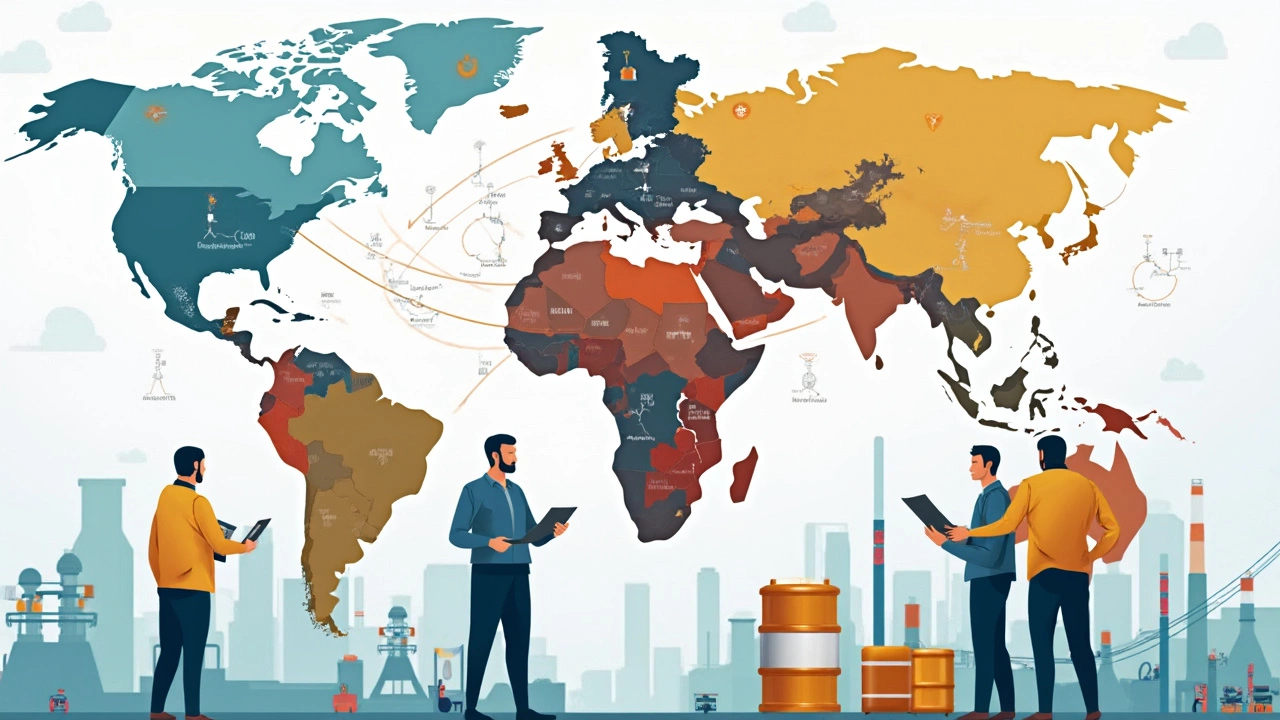When you think about the chemical industry in India, the first thing that pops up is its rapid growth and endless demand. But here's the kicker—not every chemical used by Indian manufacturers comes from within the country. Some of the most essential chemicals are actually shipped in from places like China, Saudi Arabia, and Germany.
Bulk chemicals like methanol, caustic soda, and soda ash regularly land at Indian ports. They’re essential for everything from plastics to textiles to cleaning products. No matter how big Indian factories get, sometimes the demand outpaces local supply, or it's cheaper to import from another country with easier access to raw materials.
If you’re running a business or just digging into how stuff is made here, knowing what chemicals come from abroad can give you a leg up—especially if you deal in textiles, plastics, paints, or even pharmaceuticals. It’s not just a list of names; understanding these imports helps you predict price changes, supply chain hiccups, or even the next big opportunity for local production.
- Most Imported Chemicals in India
- Reasons Behind Major Imports
- Impact on Indian Chemical Manufacturers
- Tips for Sourcing Chemicals in India
Most Imported Chemicals in India
If you walk into a typical Indian factory, chances are you'll spot raw materials shipped from abroad. Here’s what’s really entering the country—and why it matters. The chemical imports list is led by industrial staples like methanol, acetic acid, and caustic soda. These aren’t tiny markets, either. India imported about 2 million metric tons of methanol in 2024 alone, according to the Department of Commerce. That’s enough to fill over 30,000 railway wagons!
Check out the top chemicals coming in by volume and value:
| Chemical | Main Supplier Countries | Import Volume (2024, approx.) |
|---|---|---|
| Methanol | Saudi Arabia, Iran, China | 2 million MT |
| Phosphoric Acid | Morocco, Saudi Arabia | 2.1 million MT |
| Caustic Soda | China, Qatar | 650,000 MT |
| Soda Ash | USA, Turkey, Kenya | 1.5 million MT |
| Toluene | Singapore, South Korea | 350,000 MT |
| Potash (MOP) | Israel, Belarus, Russia | 3.7 million MT |
| Ethylene Glycol | Singapore, Taiwan | 950,000 MT |
| Acetic Acid | China, Malaysia | 925,000 MT |
It’s not just about big numbers. Each chemical serves a specific job. Methanol is a must for plastics and paints. Soda ash keeps the glass and detergent industries running. Potash is food for crops—no joke, farmers depend heavily on it. Most of these chemicals land at ports in Gujarat and Maharashtra before heading to manufacturers across India.
If you source materials, these names should be on your radar. Understanding who supplies what can help you plan against delays and price swings. And if you're keeping an eye on trade policy, these imports are often in the news when tariffs or global prices jump. Paying attention to official import data sites—like India's Ministry of Commerce—can help you spot trends before they catch you off guard.
Reasons Behind Major Imports
The big question is—why does India, with all its growing factories, still rely on importing so many chemicals? There’s actually a bunch of reasons, and they’re pretty practical.
- Raw Material Shortages: Making chemicals like methanol and soda ash needs certain minerals or feedstocks that India just doesn’t have in large quantities. That’s one reason countries like China and Saudi Arabia stay top suppliers.
- Price Advantage: Sometimes it’s just cheaper to buy from abroad. Take acetic acid—Chinese chemical giants churn it out at prices Indian companies can’t always match, even with shipping added in.
- Tech Gaps: India is great at making lots of stuff, but there are specialized chemicals—think certain pharma intermediates or high-purity solvents—where producers in Europe and Japan have the tech edge.
- Scale and Demand: Indian demand can spike fast in industries like textiles, dyes, or pharma. If domestic factories can’t keep up, imports fill in the gap so things don’t grind to a halt.
Just to put things in perspective, check out some numbers for the financial year 2023-24:
| Chemical | Main Supplier | Annual Import Volume (Lakh Tons) |
|---|---|---|
| Methanol | Saudi Arabia, Iran | 21 |
| Soda Ash | Turkey, China | 5.6 |
| Acetic Acid | China | 10.1 |
| Caustic Soda | China, Japan | 2.2 |
For anyone curious about how things might change, keep an eye on new chemical plants in India and government policies around anti-dumping duties or import tariffs. When local production ramps up or tariffs get tweaked, the whole game can shift pretty quickly. That’s why so many people in the chemical imports business are tracking this data all the time.

Impact on Indian Chemical Manufacturers
Let’s get into how importing chemicals shakes things up for Indian manufacturers. One of the biggest impacts is cost. Prices for stuff like methanol and phenol change a lot based on global supplies, foreign exchange rates, and quick decisions by exporting countries. So, a spike in global prices or sudden shipping issues can throw local production plans out the window.
Plenty of Indian chemical companies depend on imported raw materials to keep their factories running. Take methanol, for example. Around 60%–70% of India’s methanol demand gets covered by imports—mostly coming from Saudi Arabia and Iran. It’s a similar story for toluene and acetic acid, too. Smaller factories, without long-term contracts, often pay more and have a harder time keeping up when there’s an import crunch.
Here’s a quick look at some recent numbers for the top imported chemicals in India:
| Chemical | Annual Import Value (USD billion)* | Main Suppliers |
|---|---|---|
| Methanol | ~1.5 | Saudi Arabia, Iran |
| Phenol | ~0.5 | Singapore, Thailand |
| Soda Ash | ~0.4 | USA, China |
| Toluene | ~0.3 | China, Singapore |
*Data: Indian Ministry of Commerce, 2023-24
There’s another side to this story. Relying too much on imports makes businesses vulnerable to supply chain risks. Look back to 2021 when a global shipping crunch made chemical prices skyrocket and delayed supplies by weeks. Some Indian manufacturers saw their costs jump overnight and were forced to slow down production or even halt it temporarily.
On the flip side, these challenges spark investments in local capacity. The government’s Production-Linked Incentive (PLI) scheme encourages local chemical manufacturers to ramp up, aiming to reduce that import burden over time. Some larger Indian companies are already putting billions into new methanol and acetic acid plants. Over time, that means fewer shocks from global market swings and more business staying home.
- If you’re part of this industry, keep an eye on global raw material prices—they’re often the first sign of local cost changes coming your way.
- Don’t forget, smaller businesses should look for collective buying or long-term contracts to handle sudden price jumps.
- Startups in the chemical sector can spot gaps in the supply chain—think about what chemicals are always imported and see if local production could work for you.
There’s no escaping it: chemical imports shape nearly every part of the industry in India right now. But with smarter investing and a watchful eye on trends, local players are already finding ways to flip those challenges into a win.
Tips for Sourcing Chemicals in India
If you’re looking to get chemicals for your business in India, things work a bit differently than in Western markets. Skipping a few headaches starts with getting your supplier right. Big chemical hubs like Gujarat, Mumbai, and the Delhi NCR region host tons of distributors, but not everyone is reliable. Always ask for certifications—ISO 9001 is pretty common, while GMP matters a lot if you’re buying for pharma or food-related stuff.
Shipping costs can eat your profit if you don’t pay attention. A lot of bulk chemicals like methanol and caustic soda usually get shipped via ports in Mumbai, Chennai, and Kandla. If your supplier’s far from these, arrange pickups accordingly or check if they have local warehouses. Don’t shy away from bargaining if you’re making repeat purchases; loyalty in this market often means better deals.
Want to avoid getting stuck with delayed cargos or price fluctuations? Keep an eye on India’s import data. There are official trade portals like CHEMEXCIL and government databases showing monthly shipment stats. If you see a sudden hike in prices, it’s often due to changes in import duty or disruptions from suppliers abroad.
- Request a sample batch before a big order. You don’t want surprises down the line.
- Check the shelf life for things like solvents and specialty chemicals—they don’t last forever in Indian weather.
- For critical uses, get test reports from an NABL-accredited lab. That’s the only way to know your batch is legit.
- Ask your supplier about regulatory paperwork, especially if you’re buying stuff flagged under India’s Chemical Weapons Convention or the REACH regulation.
- Compare the rates from at least three sources before choosing your go-to supplier. Prices can shift a lot from region to region.
If you’re looking at ongoing needs, consider striking an annual contract. Many big suppliers like Tata Chemicals or Reliance can lock in prices for months, which helps with budgeting. No matter what, focus on verified, long-term partners; shady middlemen are everywhere and can mess up your supply chain. For chemical imports, close coordination with customs agents helps speed up clearances—India’s paperwork gets tricky, so being proactive makes life way easier.






